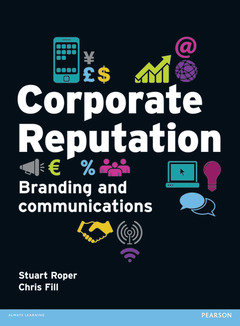Description
Corporate Reputation, Brand and Communication
Authors: Roper Stuart, Fill Chris
Language: English
Subject for Corporate Reputation, Brand and Communication:
360 p. · 19.5x26.3 cm · Paperback
Description
/li>Contents
/li>Biography
/li>Comment
/li>
Why should and how can organisations manage their reputations? All organisations, the executives who direct them, the employees who create value and their stakeholders who influence them, all interact and can impact corporate reputation.
In a 24/7 media environment, where even a tweet can shape impressions, the importance of reputation management has never been higher. Every single move, decision taken and each isolated event that involves a company or public figure, is scrutinised, documented and publicised globally, compounding the task of reputation managers. Just ask BP, Toyota or Tiger Woods.
Chapter 1 The Rise of Corporate Reputation
Chapter 2 The Scope of Corporate Reputation
Chapter 3 The Significance of Corporate Culture
Chapter 4 Measuring Corporate Reputation
Chapter 5 The Branding-Reputation Dilemma
Chapter 6 The Rise of Corporate Brands
Chapter 7 Measuring Corporate Brands
Chapter 8 The Future for Brands
Chapter 9 The Dimensions of Corporate Communication
Chapter 10 Contexts for Corporate Communication
Chapter 11 Symbols, Tools and the Media
Chapter 12 Methods of Corporate Communication
Dr Stuart Roperis Senior Lecturer in Marketing at Manchester Business School (MBS), UK. His main teaching interests focus on branding and communications, corporate reputation, marketing strategy and services marketing. He teaches undergraduate, Masters and MBA classes at the school as well as being involved in executive education with senior managers at a large number of blue chip organisations. He is the Programme Director of MBS’s Corporate Communications and Reputation Management Masters programme.
Chris Fill is a Director of Fillassociates. He has authored several books, including his internationally recognised Marketing Communications. Formerly a Principal Lecturer at the University of Portsmouth, Chris is a Visiting Professor at the Business School in Grenoble and is a Fellow of the Chartered Institute of Marketing. He was the Senior Examiner responsible for the development of the CIM’s Professional Postgraduate Diploma module, Managing Corporate Reputation.
www.fillassociates.co.uk
Chapter objectives - each chapter opens with a brief commentary on the broad issues that will be addressed to help signal the primary topics that are covered in the chapter and so guide the learning experience.
Key terms – margin notes help readers to locate relevant material quickly and highlight key issues.
ViewPoints – examples serve to demonstrate how a particular aspect of corporate reputation has been used by an organisation in a particular context. They feature companies such as Ryanair, MTV, Google, Disney and Médecins Sans Frontières.
Summaries and mini cases- a series of review and discussion questions encourage you to test your own understanding of the content of each chapter.
Online resources- students have access to further materials including short video presentations by the authors explaining the main concepts outlined by each chapter, minicases, an online glossary and annotated weblinks on the accompanying website. For lecturers there is an Instructors’ Manual, PowerPoint slides, teaching schemes and additional content.




